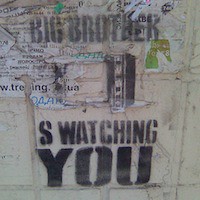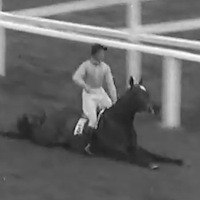Remembering the Challenger

When talking with people about events that rocked the nation during their lifetimes, many older adults point to the JFK assassination – they remember where they were and what they were doing the minute the news was announced. For those of us who were children of the ’80s, there seems to be far less for us to point to and say, “That was a big thing! I was here and doing this when I heard!”
That’s not to say nothing happened in the ’80s. Did you know President Reagan was shot? Well, shot at, at any rate? I think I remember my mother talking about it – I was barely 3 at the time. I remember the Iran-Contra Affair. I was about 9 when that trial was all that was on PBS. I watched it and remember thinking, “Why are they busting this guy’s chops? I’d be pretty panicked if I knew there were terrorists out to get me!” It only took about 15 years, but Oliver North was proven right. Children of the ’90s can point at the events of 9/11 and remember where they were and what they were doing – probably the first massive tragedy they would remember as distinctly as the assassination of JFK.
For me, the first event I remember in great detail occurred on January 28, 1986. It was the first time I’d heard of someone else with my same first name: Christa! And she was a school teacher, teaching science! I loved science and had been interested in being an astronaut when I was old enough (along with being a para-rescuer or some sort of black-ops person – I was an odd child). I remember my sister coming to pick my brother and me up from school, and I was excited about the space shuttle launch. She told me that I might not be so excited when I saw the news. I asked why and she said, “Well, it just sorta blew up.”
When we got home, it was all the news was playing. I just sat staring at the television. Over and over that image of a fireball and two plumes coming out of it replayed. I couldn’t wrap my brain around the fact I’d just watched seven people die. That incident hit me very hard – someone with my name and my same interests had just been killed in an explosion. I think that’s when I started hating my name.
Times change and years mature us, and we learn more and more. Sometimes what we remember from childhood is colored by the paradigm in which the event happened. Such is the case for this particular incident. I remember an explosion because that’s what a sudden burst of smoke could only be to an 8-year old. But there was no explosion. In fact, my brain keeps saying, “If they had just been able to retain consciousness, they could have lived.”
In a brief summary of the details of the event, the two O-rings on the SRBs malfunctioned due to cold temperatures in January in Florida. Aerodynamic anomalies, as well, contributed to the disintegration of the SRBs and fuel tanks, but did not affect the shuttle cabin. In other words, the sudden puff of smoke was the disintegration of the oxygen and hydrogen propellant tanks due to the release of extremely hot gasses that were leaking from the SRBs. YouTube has a video from actual footage of the event. If you watch, the two plumes that come off the sides of the large puff of smoke are the SRBs. They jettison as a safety precaution in an event such as this. However, the shuttle cabin lost pressure and, consequently, oxygen. The crew most likely was not conscious as the shuttle cabin plummeted to the ocean.
NASA’s official report stated that there was insufficient evidence to conclude if the crew had been conscious during the re-entry, nor was their sufficient evidence to support the idea that they were killed upon impact with the ocean. The impact disintegrated the shuttle cabin, as well as the crew.
Despite what people may believe or feel about NASA and the space program, there is evidence to support that shortcuts were taken in the preparation for the launch. Sadly, it is my opinion that the Space Program of the 1980s was driven more by greed and a desire to be the best rather than for true exploration. During the time, Russia was still considered one of the super powers and Gorbachev’s reign was still in its infancy. Perestroika and glasnost were terms still not in use by the Russian government. Perhaps my opinion may be a bit harsh, but there was some motivating factor that caused NASA officials to disregard the warnings given by the parts manufacturers for space shuttle.
Regardless of motivation or intent, five men and two women lost their lives that day. From the loss came new policies for launch and checks. It would be another 17 years before another disaster would claim another seven lives. On February 1, 2003, space shuttle Columbia disintegrated upon re-entry into Earth’s atmosphere due to a damaged heat shield. God bless the families of our fallen.
For more information, please see the following sources:
Challenger Disaster
NASA's Official Challenger Info
Federation of American Scientists' Information
That’s not to say nothing happened in the ’80s. Did you know President Reagan was shot? Well, shot at, at any rate? I think I remember my mother talking about it – I was barely 3 at the time. I remember the Iran-Contra Affair. I was about 9 when that trial was all that was on PBS. I watched it and remember thinking, “Why are they busting this guy’s chops? I’d be pretty panicked if I knew there were terrorists out to get me!” It only took about 15 years, but Oliver North was proven right. Children of the ’90s can point at the events of 9/11 and remember where they were and what they were doing – probably the first massive tragedy they would remember as distinctly as the assassination of JFK.
For me, the first event I remember in great detail occurred on January 28, 1986. It was the first time I’d heard of someone else with my same first name: Christa! And she was a school teacher, teaching science! I loved science and had been interested in being an astronaut when I was old enough (along with being a para-rescuer or some sort of black-ops person – I was an odd child). I remember my sister coming to pick my brother and me up from school, and I was excited about the space shuttle launch. She told me that I might not be so excited when I saw the news. I asked why and she said, “Well, it just sorta blew up.”
When we got home, it was all the news was playing. I just sat staring at the television. Over and over that image of a fireball and two plumes coming out of it replayed. I couldn’t wrap my brain around the fact I’d just watched seven people die. That incident hit me very hard – someone with my name and my same interests had just been killed in an explosion. I think that’s when I started hating my name.
Times change and years mature us, and we learn more and more. Sometimes what we remember from childhood is colored by the paradigm in which the event happened. Such is the case for this particular incident. I remember an explosion because that’s what a sudden burst of smoke could only be to an 8-year old. But there was no explosion. In fact, my brain keeps saying, “If they had just been able to retain consciousness, they could have lived.”
In a brief summary of the details of the event, the two O-rings on the SRBs malfunctioned due to cold temperatures in January in Florida. Aerodynamic anomalies, as well, contributed to the disintegration of the SRBs and fuel tanks, but did not affect the shuttle cabin. In other words, the sudden puff of smoke was the disintegration of the oxygen and hydrogen propellant tanks due to the release of extremely hot gasses that were leaking from the SRBs. YouTube has a video from actual footage of the event. If you watch, the two plumes that come off the sides of the large puff of smoke are the SRBs. They jettison as a safety precaution in an event such as this. However, the shuttle cabin lost pressure and, consequently, oxygen. The crew most likely was not conscious as the shuttle cabin plummeted to the ocean.
NASA’s official report stated that there was insufficient evidence to conclude if the crew had been conscious during the re-entry, nor was their sufficient evidence to support the idea that they were killed upon impact with the ocean. The impact disintegrated the shuttle cabin, as well as the crew.
Despite what people may believe or feel about NASA and the space program, there is evidence to support that shortcuts were taken in the preparation for the launch. Sadly, it is my opinion that the Space Program of the 1980s was driven more by greed and a desire to be the best rather than for true exploration. During the time, Russia was still considered one of the super powers and Gorbachev’s reign was still in its infancy. Perestroika and glasnost were terms still not in use by the Russian government. Perhaps my opinion may be a bit harsh, but there was some motivating factor that caused NASA officials to disregard the warnings given by the parts manufacturers for space shuttle.
Regardless of motivation or intent, five men and two women lost their lives that day. From the loss came new policies for launch and checks. It would be another 17 years before another disaster would claim another seven lives. On February 1, 2003, space shuttle Columbia disintegrated upon re-entry into Earth’s atmosphere due to a damaged heat shield. God bless the families of our fallen.
For more information, please see the following sources:
Challenger Disaster
NASA's Official Challenger Info
Federation of American Scientists' Information

Related Articles
Editor's Picks Articles
Top Ten Articles
Previous Features
Site Map
Content copyright © 2023 by Christa Mackey. All rights reserved.
This content was written by Christa Mackey. If you wish to use this content in any manner, you need written permission. Contact Lane Graciano for details.







